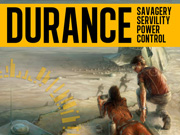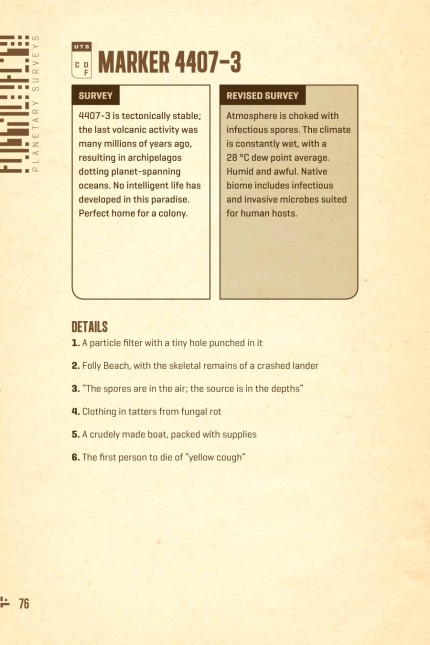Reading – Durance RPG

The Durance Kickstarter project promised a roleplaying game in which the players would work together to craft a story about a sci-fi prison colony. There was a lot more to it, but it was that simple concept — combined with the number of people I knew who were buzzing about the game — that made me go ahead and back the project. I wasn’t completely sure what to expect, but given the track record of the publisher (Bully Pulpit Games) I was pretty sure that at the very least a read through the book would entertain me.
I was right. And, more importantly, I now find myself hoping that I can find the time and people to sit down and give the game a try. Because while Durance follows the roleplaying game trend of being too long (see “Tabletop Roleplaying Games are Too Long”) what it does it does very well. And once you get into the book you realize that the rules are only about 40 pages; most of the book is background information on several possible colonies where your game may be based.

Freeform, Group-Led Storytelling
From the beginning Durance makes it clear that it’s not going to be a game about tracking the hit points and character stats for all of the party. Durance is more of a tool to build stories than a traditional roleplaying game, which characters defined by their position in the colony — the society is divided into two camps, “Authority” and “Convicts,” and those are subdivided into “rungs” like a ladder — and one oath/core belief that the character will never break.
And the game is about how the group of players — characters are communal property in the game and expected to be used and abused — then force each character to break his oath. Once an oath is broken the character is removed from the story and once more than half of the characters in the game (each player has two) are removed from play it’s time to bring the story to an end.

The Game Starts With a World
As a sci-fi game set on one of a number of different worlds the first step to a Durance game — and one aspect of the rules that I found especially entertaining — is the creation of the colony. At the start of the game the players take a “Planetary Survey” form (see below) and then take turns eliminating and selecting options. Starting with the first player each player chooses one part of the form to be true and crosses out a second as false. Once the “Planetary Survey” and “Colonial Records” section each have three crossed out and three selected options then that stage is complete and players can find out which colony they’ll be playing in.

The remaining words in each of those two sections create a code that is then referenced in the book to determine the world and then the colony details. So if players crossed out “Atmosphere, Biology,” and “Climate” and selected “Geology, Hydrology,” and “Intelligent Life” then the first code would be CDF. Checking the book we find one page devoted to CDF and full details on Marker 4407-3, including both an official survey report and then what the colonists really find. The world is never as nice as the official report makes it sound. The following image shows the page on Marker 4407-3 from the book, giving you all of the details on the world.

There are a total of twenty different worlds described in the Durance book, one world for every possible combination of codes on the “Planetary Survey” form. And, even better, the same “choose and eliminate” process on the “Colonial Records” section of the form leads to twenty possible colonies that each have their own page describing the colony from the point of view of the guards and again from the point of view of the convicts. World creation alone is a subgame before the main game, and the worlds created during this stage look like great stages for some exciting games.
Drive and Uncertainty
There is a final step in the world creation: choosing the third “Drive” for the game. There are two pre-established Drives — identified as “Servility” and “Savagery” — and then through the process of eliminating choices the players choose the third Drive for the game. Drives are what help guide the story when players decide it’s time to “go to the dice” by rolling dice and comparing positioning and results. The image below shows a game in which “Safety” was selected as the third Drive — the characters will make decisions based on their personal safety — and in this example “Safety” is the dominate Drive for the scene. So in an undecided scene in which there is conflict a player will choose what is safest for the character in question.

There’s not a lot of dice rolling in a game of Durance. If a player wants to kill a character then he simply kills that character. As freeform storytelling the idea is for everyone to work together to tell a tale, but the big rule is to never say “that didn’t happen.” Go with the flow. Adapt. Improvise. Work with what the other players are spinning and help them craft the story and lead it down a path you want to take.
As with most roleplaying games Durance is a cooperative game in which there is no winner, but as in most roleplaying games individual players will want what is best for their characters. It’s just natural to want to win . . . even when you technically cannot win.
Closing Thoughts
These days I still read a lot of roleplaying games (as research and to keep in touch with the market), but there’s rarely any time to sit down and actually play a roleplaying game. With Durance the publisher, Bully Pulpit Games, has created the tools for stories that I want to experience. I want to make the time to play a game or two of Durance, and to me that points to the game as a successful product.
Is it a great and successful game? I don’t know and won’t know until I play it a few times. But as a product it’s hugely successful in my eyes because:
- The game leads players to tell stories and not just try to acquire more treasure. Treasure is great, but these days I need more.
- The tools/rules are very simple. In less than 40 pages the book gives you the rules necessary to play. I appreciate that.
- The flexibility is amazing. I love the world creation system and the lightly-directed nature of the way dice work in the game sound fun. The success or failure of the game hinges on the players and not the dice. That’s always good.
- The book is gorgeous. Fantastic layout, beautiful art, and everything about the book is clean and attractive.
Overall, Durance has greatly impressed me. I am very happy that I took a chance and backed the Kickstarter project.
